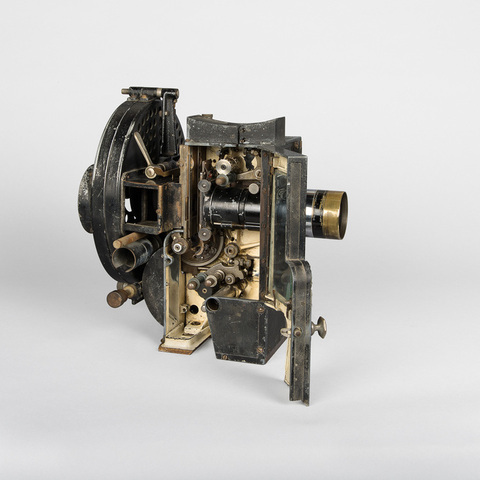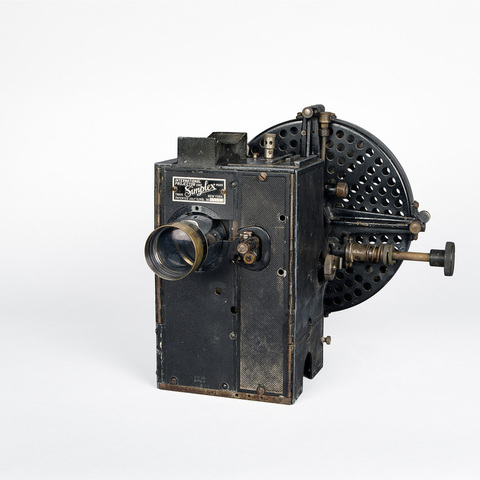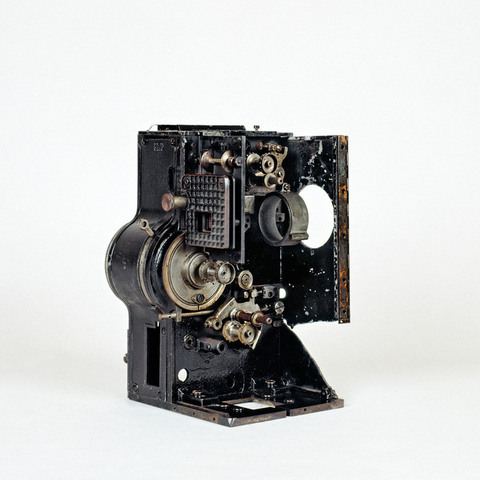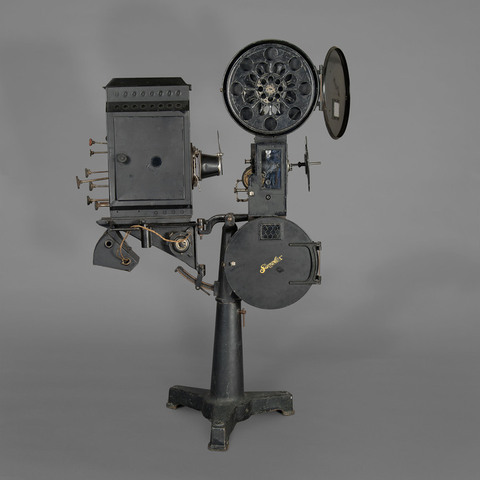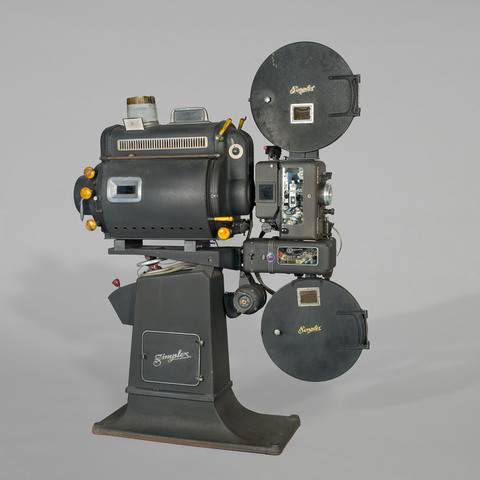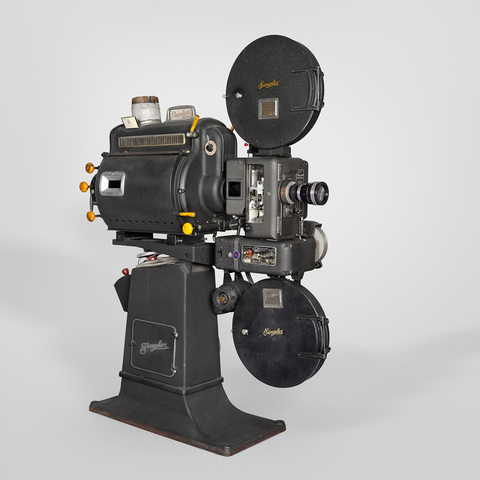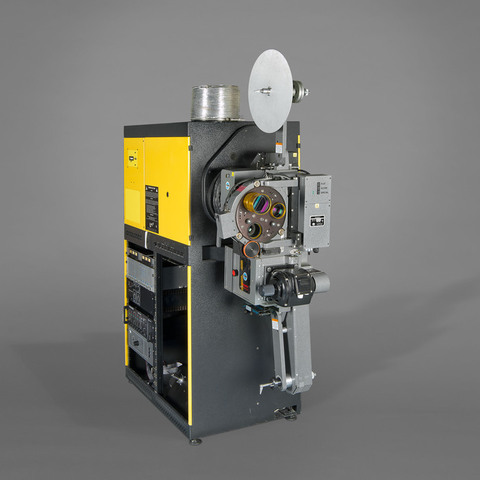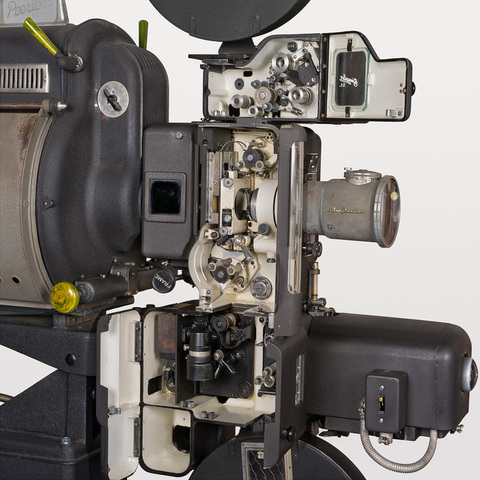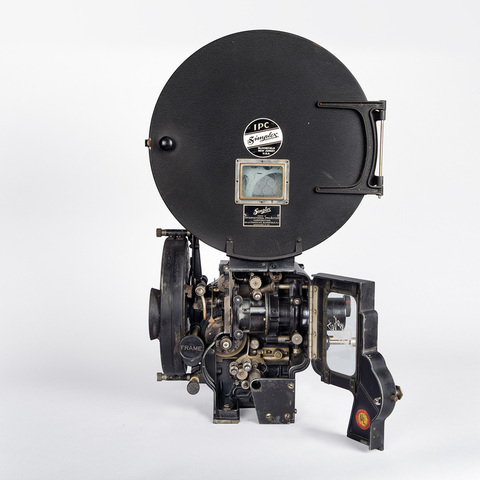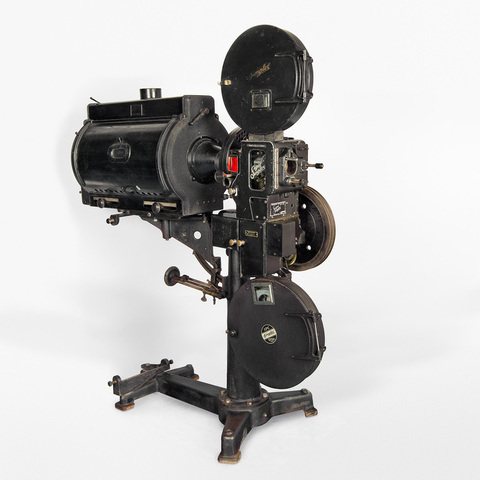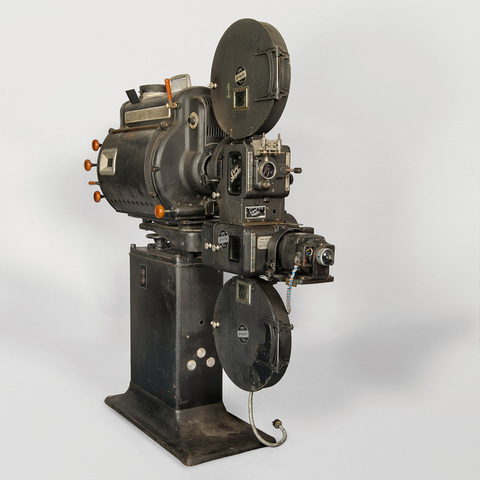Projecteur de film 35 mm sonore
Fiche détaillée
Type de l'appareil
entraînement du film 35 mm sonore par croix de Malte à bain d'huile ; trois débiteurs dentés ; obturateur ventilateur à deux pales réglables sous carter ; volet coupe-feu
Auteurs
Informations non disponibles
Fabricants
International Projector Corporation
New York, 88-96 Gold Street, New York
Utilisateurs
Informations non disponibles
Distributeurs
Brockliss-Simplex
Paris, 6 rue Guillaume-Tell
International Projector Corporation
New York, 88-96 Gold Street, New York
Sujet du modèle
Informations non disponibles
Objectif
Super-Lite 5 1/4 INEF Series III C Projection Optics Co., Inc. Rochester N.Y. USA
Taille de l'objet
Ouvert :
Informations non disponibles
Fermé :
Longueur : 46 cm
Largeur : 46 cm
Hauteur : 81 cm
Diamètre :
Informations non disponibles
Taille de la boîte de transport
Informations non disponibles
Remarques
Marques : "International Projector Corp. Simplex Trade Mark New York, Patented July 11, 1916, n° 47 837" ; "International Projector Corp. New York City, Patents 1 075 695, 1 1905 82, Patents pending" ; "This machine is sold by International Projector Corporation, of New York, N. Y., with the express license restriction that it may be used only with the parts made by said company. The use of this machine with any other parts, will constitute an infringement of patent and operate as a revocation of all license to use said machine".
Le premier Simplex a été fabriqué de 1907 à 1924 (CNC AP-97-818). Un deuxième modèle plus évolué suit (ce modèle), de 1925 à 1936, d'abord livré avec un obturateur avant, puis avec un obturateur arrière sous carter. Un troisième modèle ("Super Simplex" (avec obturateur arrière sous carter) est fabriqué de 1937 à 1946 (CNC AP-18-1331). Puis vient le Simplex X-L (AP-12-2760 et 2761).
"Pour suppléer aux besoins des directeurs de cinémas ayant installé le modèle régulier de projecteur Simplex, nous avons fabriqué et lancé sur le marché un nouvel obturateur ventilateur arrière semblable à celui du Super Simplex. Cet ensemble est fixé au mécanisme standard et donne les mêmes avantages que l'obturateur du Super Simplex. Ce nouvel ensemble comprend plusieurs caractéristiques particulières au Super Simplex, tel que le nouveau système d'ouverture de la porte de projection, écran protecteur des yeux, nouveau système de cadrage avec lampe pilote et mécanisme de réglage de l'obturateur. Tout ceci est commandé du côté de l'opérateur, c'est à dire à droite de l'appareil. [...] L'obturateur arrière répond entièrement et exactement au besoin actuel de la projection en donnant plus de lumière et en réduisant en même temps la chaleur sur la fenêtre de projection. L'illumination est augmentée considérablement, le pourcentage d'augmentation dépendant de la longueur focale et du type d'objectif employé, la chaleur à la fenêtre est réduite de 50 à 75 %" (Obturateur ventilateur arrière pour type standard de projecteurs Simplex, Paris, Brockliss & Cie, s.d.).
"La Croix de Malte et son plateau peuvent aisément être regardés comme les plus importantes pièces du mécanisme. La fonction de ces deux pièces précises est de tirer de haut en bas devant la fenêtre de projection et de le tenir immobile dans cette position tant que l'image est exposée à l'écran. Ceci signifie que durant la vision d'un film d'environ 300 mètres, ce film doit s'arrêter et repartir 16 000 fois sans qu'il y ait vibration ni jeu des dents. Cet arrêt constant, suivi de départ, impose un formidable effort à la Croix de Malte et à son plateau. Pendant la période d'immobilisation du film, une des parties concaves de la croix de Malte s'emboîte exactement sur la portion du disque cylindrique du plateau et permet juste à une mince pellicule d'huile de travailler entre les deux surfaces. Il doit être gardé à l'esprit que le mouvement en travaillant à la vitesse de la projection, développe entre les deux surfaces de la croix de Malte et du plateau, une certaine friction ; or qui dit friction dit chaleur. Qui dit chaleur, dit dilatation : laquelle si elle est trop forte tend à resserrer les pièces l'une contre l'autre" (Manuel d'instructions, Appareil de projection Simplex, Concessionnaire pour la France, la Belgique et la Suisse, Brockliss-Simplex S.A., Paris, Brockliss-Simplex, s. d.).
"[...] Between 1904 and 1922, Nicholas Power obtained 57 patents covering the design and construction of important improvements in Power's projectors N° 4, 5, 6, 6A, the latter being the last one manufactured. [...] Many other patents were issued to Nicholas Power Co., including a great number covering a complete motion picture projector embodying numerous basic ideas and improvements. The year 1911 saw only two active projector manufacturers ; but beyond the horizon was brewing a storm of formidable proportions, the first faint clouds of which were barely visible. The Simplex projector was on the way. In 1909 two new organisations had entered the field : the Precision Machine Co., which took over the inventions of Francis B. Cannock which were represented by the Edengraph, forerunner of the Simplex Projector ; and the American Motion Picture Machine Co., which developed the Standard projector. The latter company failed in 1913, however, leaving but three surviving projector manufacturers : Nicholas Power, Precision Machine Co., and Enterprise Optical Co. The Precision group lost no time in giving strenuous and persistent battle to Nicholas Power, and after only three years of intensive competition the Simplex projector was firmly established on the market. Thus was established the basis for the famous Power-Simplex feud, with the proponents of each projector proving ready literally at the dropping of a word to vociferously, and often militantly, defend the projector of their choice. The Simplex projector was of entirely different design from the Powers in that is was a considerably more compact mechanism completely enclosed, being on a pedestal of entirely new design and having a great many features which appealed tremendously to the projectionnist. Precision also built up an excellent patent structure covering, among many others, the following salient features : 1) The basic patent covering the entire equipment and including the new framing device by means of which this operation was accomplished by rotating the intermittent casing about the intermittent sprocket axis. 2) A new method of focusing lenses on projectors. 3) An entirely new gate and film-holding structure to maintain the film in the correct optical plane above the intermittent sprocket. 4) Complete enclosures for the mechanism, all prior mechanisms being of the open type with gears exposed. 5) The method of framing the picture in the Simplex mechanism. 6) An improved film-gate door lock, enabling the projectionist to easily close and latch the film-enclosing gate. 7) An entirely new design of fire valve for film magazines. 8) An entirely new type of mechanically-controlled variable-speed device for use with constant speed motors on projectors. The corporate existence of International Projector Corp. dates from 1925 as a result of the merging of Precision Machine Co., Nicholas Power Co., and the Acme Motion Picture Projector Co., with all manufacturing facilities and personnel being concentrated at 90 Gold Street, New York City. This consolidation ushered in a new era of development in projector manufacture, one of the early fruits of which was the Super Simplex mechanism. This projector, while resembling to some extent the older regular Simplex mechanism, embodied many improvements making for better visual projection, greater ease of operation, and considerably more efficient handling of the lens system. A great improvement was made in the intermittent movement by the development at the plant of machinery for manufacturing the operating parts of the movement, that is, the star wheel and cam, and for obtaining far greater accuracies than were obtainable previously. Another major Super Simplex development was the removal of the revolving cut-off shutter to the rear of the projector so that is interposed between the illuminant and the aperture plate. Other Super Simplex improvements involved a new type pad roller arm for accuretely maintaining the film on the sprockets, a threading lamp for quick and accurate framing before projection, and an assembly of enclosures for the entire mechanism. [...] The Regular Simplex mechanism which first appeared as a single-bearing unit and then gave way to the double-bearing alignment. The Super Simple into the manufacture of which was introduced to the trade the practice of hardened-and-ground sprockets. This unit also featured the rear shutter mechanism. The Simplex E17 which included a double shutter and a one-shot oiling system which embraced all moving elements except the intermittent movement. The Simplex E7 which included a double shutter and radical advances as to constitute probably the most important milestone in projector manufacture. On the sound reproduction front, Simplex brought out in 1938 the famous Simplex 4-Star sound system which was the first to utilize permanent magnet speakers. This was followed in 1950 by the radically new design of X-L loudspeakers for use in both enclosed and open-air theatres. In 1954, Simplex scored another notable advance when it made available to the sorely pressed motion picture industry a 4-track magnetic sound reproducer system" (Edward B. Garrison, "Evolution of the Simplex Projector", International projectionist, July 1954, p. 30-44.)
Bibliographie
Obturateur ventilateur arrière pour type standard de projecteurs Simplex, Paris, Brockliss & Cie, s.d.
Manuel d'instructions, Appareil de projection Simplex, Concessionnaire pour la France, la Belgique et la Suisse, Brockliss-Simplex S.A., Paris, Brockliss-Simplex, s. d.
